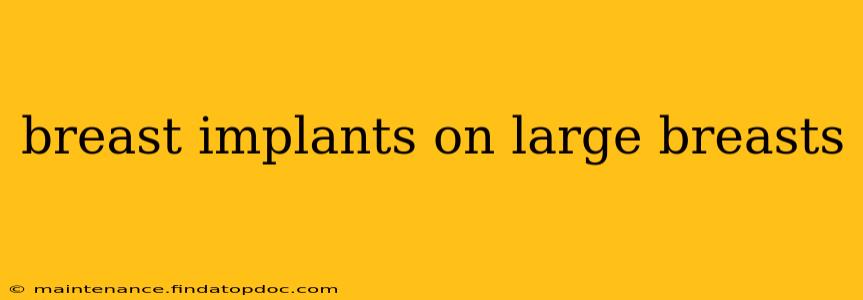Many women with naturally large breasts consider breast implant surgery, but their motivations often differ from those with smaller breasts. While some seek augmentation to enhance size further, others aim for a reduction or lift to improve proportions, reduce back pain, or enhance overall shape and confidence. This comprehensive guide explores the complexities of breast implant surgery for women already possessing large breasts, addressing common questions and concerns.
Why Would Someone with Large Breasts Want Implants?
This isn't as counterintuitive as it might seem. Women with large breasts often seek implants for several reasons beyond simply wanting larger breasts:
-
Breast Reduction with Implants: This involves removing excess breast tissue and then placing implants to achieve a more aesthetically pleasing shape and size. It’s a common procedure for women who experience back pain, neck pain, or shoulder grooves due to the weight of their breasts. The implants help restore natural breast volume after tissue removal.
-
Breast Lift (Mastopexy) with Implants: Large breasts can sag over time due to gravity, weight loss, or pregnancy. A mastopexy lifts and reshapes the breasts, and implants can be added to restore volume lost during the lift or to increase breast size. This creates a more youthful, perky appearance.
-
Improve Breast Shape and Symmetry: Even naturally large breasts might have asymmetries in size or shape. Implants can help correct these imperfections, creating a more balanced and symmetrical appearance.
-
Improve Clothing Fit: Large breasts can make it challenging to find well-fitting clothing. Strategic implant placement during a breast reduction or lift can help improve the overall shape and size, allowing for a better fit in clothes.
What are the Risks and Considerations?
Breast implant surgery, regardless of the initial breast size, carries inherent risks. For women with already large breasts, some considerations are amplified:
-
Increased Scarring: The larger the breast, the larger the incision might need to be, potentially leading to more prominent scarring.
-
Longer Recovery Time: Larger breasts require more extensive surgery, which often translates to a longer recovery period.
-
Higher Risk of Complications: While rare, complications like infection, capsular contracture (hardening of the scar tissue around the implant), or implant rupture can occur. These risks might be slightly higher in patients with larger breasts due to the increased surgical complexity.
-
Nerve Damage: Due to the location of nerves in the breast, there's a potential for nerve damage during surgery. This risk is relatively low, but it's something to discuss with your surgeon.
What Type of Implants Are Best for Large Breasts?
The choice of implant type (saline or silicone) and placement (under the muscle or over the muscle) depends on several factors, including individual anatomy, desired outcome, and surgeon preference. Your surgeon will discuss the most suitable options for your specific case. They will assess your breast tissue, muscle thickness, and overall body type to recommend the optimal approach.
How Much Will the Surgery Cost?
The cost of breast implant surgery for large breasts will vary depending on the complexity of the procedure, the surgeon's fees, anesthesia costs, and facility charges. It’s essential to obtain detailed cost breakdowns from multiple surgeons before making a decision.
What is the Recovery Process Like?
Recovery after breast implant surgery can last several weeks or even months, depending on the extent of the procedure. Expect some discomfort, bruising, swelling, and limited mobility initially. Your surgeon will provide detailed post-operative instructions to ensure optimal healing.
Can I Breastfeed After Breast Implant Surgery?
Breastfeeding after breast implant surgery is usually possible, although it's crucial to discuss this with your surgeon beforehand. The location of the implant placement can influence the impact on breastfeeding.
What are the Long-Term Effects of Breast Implants?
The long-term effects of breast implants are still being studied. Regular checkups with your surgeon are essential to monitor implant integrity and overall health.
This information is for educational purposes only and should not be considered medical advice. Always consult with a qualified and experienced plastic surgeon to discuss your specific situation and determine the best course of action for you. Thoroughly research surgeons, and don't hesitate to ask questions until you feel completely comfortable and informed about the procedure.
